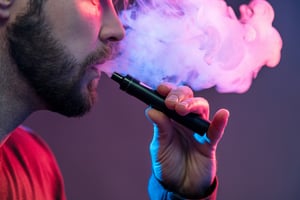Broughton's Head of Regulatory Affairs, Lloyd Smart discusses the latest UK Medicines & Healthcare products Regulatory Agency (MHRA) guidance on licensing electronic cigarettes as medicines and...
E-cigarette Safety. The Evidence is Growing
Nicotine

Jul 5, 2018 | Published by Leslie Henderson
Nicotine
Electronic cigarettes are battery powered electronic devices that enable delivery of nicotine to a user without the combustion processes of tobacco. They were first developed by the pharmacist Hon Lik in 2003¹. From its beginning to now, developments in the industry have focused on improving user experience and functionality. The first-generation e-cigarettes imitate cigarettes in both size and appearance hence the name cig-a-likes. Second generation e-cigarettes, like eGo pens, are bigger than combustible cigarettes and first-generation e-cigs but contain ‘fire’ buttons to induce vaporisation. Third generation or Advanced Personal Vaporisers (APVs) also possess a ‘fire’ button and are manufactured in various shapes and sizes. APVs allow user modification to vary functions like power, temperature and air flow which influences vapour generating capacity. Components such as atomisers and battery life have improved in function and ability through each generation.
The increase in popularity of electronic nicotine delivery systems has prompted the debate on the safety and risk associated with e-cigarettes. The devastating health effects of combustible tobacco demonstrate the need for caution. Are e-cigarettes harmful and what do they contain that has potential to harm?
The Features and Composition of E-cigarettes and Their Health Implications
The component of interest is the e-liquid within the e-cigarette. E-liquids consists of propylene glycol and glycerol base solutions² to which nicotine, water and flavourings are added. Nicotine administered through the e-liquid is proportional to the nicotine concentration of the liquid and the aerosol generated. Typically, e-liquids with high nicotine concentrations are used with low aerosol generating devices while e-liquids with low nicotine concentrations are often combined with high aerosol generating devices.
E-liquid composition can contain various chemicals depending on the complexity of its flavour. Original ‘simple’ flavours such as apple contain less chemicals than new and complex flavours like apple pie and custard or lemon cheesecake. Chemicals used in flavourings are either pharmaceutical or food grade quality. They are deemed safe for ingestion but that potentially may not be the case for inhalation. Inhalation of the vapour requires the e-liquid to be heated to high temperatures (approx. 250 – 300°C). Elevated temperatures could induce physical or chemical changes to the e-liquid and its constituents leading to the potential formation of toxic compounds.
The two main components of an e-liquid, propylene glycol and glycerol, have been shown to potentially generate carbonyl compounds with established toxic properties when exposed to high temperatures³. These could be compounds such as formaldehyde, acetaldehyde and acrolein⁴. In addition, metallic components from heating elements in e-cigarettes have potential to release trace metals into the vapour⁶. Carbonyl compounds and metals produced are known to be carcinogens of varying degrees⁷.
Knowledge around the adverse effects of e-cigarettes is limited but growing. The acute toxicity of e-cigarettes has been heavily researched however chronic toxicity data is not available yet. Although limited data has been generated to date, regulations are encouraging manufacturers to provide data to prove their products are safe and support their licence for marketing their products.
Legislation
The Tobacco Product directive (TPD) and Pre-market tobacco authorisation (PMTA) are measures by regulatory agencies in the EU and US, respectively, to evaluate electronic nicotine devices in the interest of protecting public health. The following areas are requirements of TPD (article 20 of directive 2014/40/EU) which manufacturers and importers of electronic cigarettes and refill containers must supply to the relevant regulatory agency for which they would like to market their products:
- Details of the manufacturer or importer
- List of Ingredients and emissions
- Toxicology data relating to the ingredients and emissions
- Nicotine dose
- Product components including packaging
- Production process,
- and declaration of quality and safety
TPD also enforces restrictions on the volume of refill containers, nicotine concentration, additives/colourants used and labelling of the product⁸.
PMTA regulation has far more stringent requirements. From a product constituent perspective, the following are required for a PMTA application:
- Full reports of information which is known or reasonably known to show the health risks of the tobacco products.
- A full statement of the tobacco products constituents including quantities of identified harmful and potentially harmful constituents (HPHC’s).
- Description of manufacturing processes including facilities, methods and packing procedures used.
- Product stability data to prove that the product does not degrade and change over time.
- Tobacco product standard references and labelling proposed to be used for the product⁹.
The US PMTA regulations also require that extensive clinical data is gathered to demonstrate human health impact of the product.
Legislation created around e-cigarettes encourages manufacturers to research and document the health risks to promote and protect public health. This allows e-cigarette consumers to have information at hand so that they can make an informed decision on the use of these products.
E-cigarettes vs Cigarettes
Public Health England ¹⁰ estimates that e-cigarettes are around 95% safer than combustible tobacco. The harmful components of cigarette smoke are either absent or at lower levels in e-cigarette vapour¹¹. Carbonyl compounds are found at much lower levels in vape than in combustible cigarette smoke¹². As mentioned, chronic toxicity of e-cigarettes is unknown however a reduction in carcinogenic compounds administered within the vapour are a promising prospect. A study by Action on Smoking and Health (ASH-UK) found that young people who did not smoke did not continue with e-cigarette use after the study¹³. The conclusion being that they are less likely therefore to be a ‘gateway’ into smoking. Guodong Liu et al.¹⁴ found e-cig users reported less dependence on their product than cigarette smokers and are therefore more likely to quit.
The industry needs safer nicotine delivery systems and e-cigarettes are the beginning of that process. E-cigarettes, in the future, may even be able to deliver nicotine as safely as caffeine is delivered in coffee.
The End of Combustible Tobacco?
Combustible tobacco usage is falling but remains a massive hindrance on public health. Tobacco is one of the world’s biggest killers and causes various health implications for its users.
Industry experts and regulators are working together to demonstrate that high quality e-cigarettes and e-liquids offer the potential to substantially reduce exposure to cigarette HPHCs in smokers who use such products as alternatives to cigarettes. The reduced risk associated with e-cigarettes makes them likely aides for stopping smoking. The improved health impacts could mean the future is cigarette free with e-cigarettes leading the way.
References
- Kaur, G., Pinkston, R., Mclemore, B., Dorsey, W. and Batra, S. (2018). Immunological and toxicological risk assessment of e-cigarettes. European Respiratory Review, [online] 27(147), p.170119. Available at: http://err.ersjournals.com/content/27/147/170119.full [Accessed 28 Jun. 2018].
- Logue, M. Sleiman, V. Montesinos, M. Russell, M. Litter, N. Benowitz, L. Gundel and H. Destaillats, Environmental Science & Technology, 2017, 51, 9271-9279.
- Jensen, R., Strongin, R. and Peyton, D. (2017). Solvent Chemistry in the Electronic Cigarette Reaction Vessel. Scientific Reports, [online] 7, p.42549. Available at: https://www.nature.com/articles/srep42549 [Accessed 28 Jun. 2018].
- Varlet, V. (2016). Drug Vaping: From the Dangers of Misuse to New Therapeutic Devices. Toxics, [online] 4(4), p.29. Available at: https://search-proquest-com.lcproxy.shu.ac.uk/docview/1858320326?accountid=13827&rfr_id=info%3Axri%2Fsid%3Aprimo [Accessed 28 Jun. 2018].
- Farsalinos, K., Gillman, G., Poulas, K. and Voudris, V. (2015). Tobacco-Specific Nitrosamines in Electronic Cigarettes: Comparison between Liquid and Aerosol Levels. International Journal of Environmental Research and Public Health, [online] 12(8), pp.9046-9053. Available at: https://search-proquest-com.lcproxy.shu.ac.uk/docview/1711615447?accountid=13827&rfr_id=info%3Axri%2Fsid%3Aprimo [Accessed 28 Jun. 2018].
- Williams, M., Villarreal, A., Bozhilov, K., Lin, S. and Talbot, P. (2013). Metal and Silicate Particles Including Nanoparticles Are Present in Electronic Cigarette Cartomizer Fluid and Aerosol. PLoS ONE, [online] 8(3), p. e57987. Available at: http://journals.plos.org/plosone/article?id=10.1371/journal.pone.0057987 [Accessed 29 Jun. 2018].
- José, R. (2015). Potential risk of carcinogens in e-cigarette vapour. BMJ, [online] p.h5004. Available at: https://doi-org.lcproxy.shu.ac.uk/10.1136/bmj.h5004 [Accessed 28 Jun. 2018].
- UK. (2018). E-cigarettes: regulations for consumer products. [online] Available at: https://www.gov.uk/guidance/e-cigarettes-regulations-for-consumer-products [Accessed 29 Jun. 2018].
- gov. (2018). Premarket Tobacco Applications. [online] Available at: https://www.fda.gov/TobaccoProducts/Labeling/TobaccoProductReviewEvaluation/ucm304506.htm [Accessed 29 Jun. 2018].
- Public Health England (2015). E-cigarettes: an evidence update. London: PHE, p.6.
- Mayor, S. (2017). E-cigarettes users have lower carcinogen and toxin levels than smokers, study finds. BMJ, [online] p.j651. Available at: https://doi-org.lcproxy.shu.ac.uk/10.1136/bmj.j651 [Accessed 28 Jun. 2018].
- Varlet, V., Farsalinos, K., Augsburger, M., Thomas, A. and Etter, J. (2015). Toxicity Assessment of Refill Liquids for Electronic Cigarettes. International Journal of Environmental Research and Public Health, [online] 12(5), pp.4796-4815. Available at: http://www.mdpi.com/1660-4601/12/5/4796 [Accessed 29 Jun. 2018].
- Use of e-cigarettes (vapourisers) among adults in Great Britain. (2018). [ebook] ASH UK. Available at: http://ash.org.uk/information-and-resources/fact-sheets/use-of-e-cigarettes-among-adults-in-great-britain-2017/ [Accessed 29 Jun. 2018].
- Liu, G., Wasserman, E., Kong, L. and Foulds, J. (2017). A comparison of nicotine dependence among exclusive E-cigarette and cigarette users in the PATH study. Preventive Medicine, [online] 104, pp.86-91. Available at: https://doi.org/10.1016/j.ypmed.2017.04.001 [Accessed 29 Jun. 2018].



